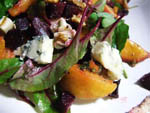How to make the perfect salad
Sybil Kapoor investigates the skills and ingredients required to make the perfect salad


As summer deepens across the land, danger lies in wait for the unwary gastronome-the ambush of an ill-made salad-for it is at this time of year that salad reigns supreme on British tables. No meal is complete without a bowl of verdant leaves or basil-strewn tomatoes. Perfectly made, it's sublime, but, at its worst, the salad is a dish to dread. As a result, British cooks and gourmets alike have dedicated much ink to devising the perfect salad. In 1699, John Evelyn tackled the subject in his book Acetaria: A Discourse of Sallets. He writes: ‘Every plant should come in to bear its part, without being over-power'd by some herb of a stronger taste, so as to endanger the native sapor and vertue of the rest; but fall into their places, like the notes in music, in which there should be nothing harsh or grating.'
Evelyn's book remains a beacon of enlightenment. While at a barbecue, eating a travesty of a salad - canned sweetcorn, kidney beans, green beans and mushrooms tossed in ready-made dressing -I wonder what my hosts would have made of his suggestions, such as combining nasturtium flowers with Roman lettuces and various cresses. Purslane, pickled ash keys, young pea pods, fennel and wood sorrel hint at the many delicacies he suggests.
Over the centuries, cooks have railed against over-dressed, limp, vinegary salads, and advised against using anything but the freshest, youngest salad leaves and vegetables. Much energy has been dedicated to perfecting dressings, one of which is English salad sauce. This is not to be confused with ready-made salad cream-a horror that should be left in a time capsule with Spam.
Freshly made salad sauce dates back to Evelyn's time. It's made by blending hard-boiled egg yolks with vinegar, cream, olive oil and mustard and can be surprisingly good, although I have my doubts about Recipe for a Salad (1839), a poem that Sydney Smith sent to Lady Holland and that includes sieved potatoes.
Of course, life has improved since Elizabeth David wrote in Summer Cooking (1955): ‘How one learns to dread the season for salads in England.' In a bid to counteract such horrors as soggy lettuce, baked beans and synthetic dressings, she advocates fresh produce, sensitively prepared and lightly dressed at the last minute with a good olive oil and a little lemon juice.
Today, we have a wonderful array of salad ingredients to play with, from verjuice and nutty flavoured cold-pressed rapeseed oil to peppery rocket and red mizuna leaves. It's hard to go wrong if you follow the advice of David and Evelyn. For ultimate salad perfection, consider the taste, texture and colour of your proposed medley. Seek the right balance between the five tastes of sweet, sour, salt, bitter and savoury.
Usually, I take the taste of the dominant ingredient and consider what would enhance it-for example, the lemony acidity of fresh goat's cheese intensifies the sweetness of a beetroot salad, just as bitter olives add a note of sophistication to a sweet roasted-pepper salad.
Sign up for the Country Life Newsletter
Exquisite houses, the beauty of Nature, and how to get the most from your life, straight to your inbox.
Then, consider its ‘mouth-feel'. Ideally, the dominant food texture should be quite similar, although a little textural contrast doesn't go amiss. Thus, crispy-bacon pieces will add an element of surprise to a soft-textured lettuce, avocado and prawn salad.
Lastly, make sure that it looks gorgeous. A smoked-salmon and chicory salad, for instance, is transformed by a splash of crème fraîche and a scattering of chive flowers. Summer on a plate.
Country Life is unlike any other magazine: the only glossy weekly on the newsstand and the only magazine that has been guest-edited by HRH The King not once, but twice. It is a celebration of modern rural life and all its diverse joys and pleasures — that was first published in Queen Victoria's Diamond Jubilee year. Our eclectic mixture of witty and informative content — from the most up-to-date property news and commentary and a coveted glimpse inside some of the UK's best houses and gardens, to gardening, the arts and interior design, written by experts in their field — still cannot be found in print or online, anywhere else.
-
 Diamonds are everyone's best friend: The enduring appeal of one of Nature's sparkliest treasures
Diamonds are everyone's best friend: The enduring appeal of one of Nature's sparkliest treasuresEvery diamond has a story to tell and each of us deserves to fall in love with one.
By Jonathan Self
-
 RHS Chelsea Flower Show: Everything you need to know, plus our top tips and tricks
RHS Chelsea Flower Show: Everything you need to know, plus our top tips and tricksCountry Life editors and contributor share their tips and tricks for making the most of Chelsea.
By Amie Elizabeth White